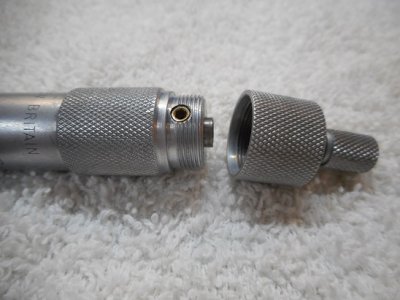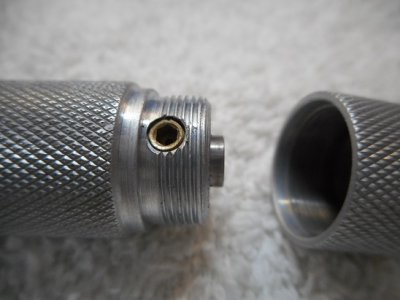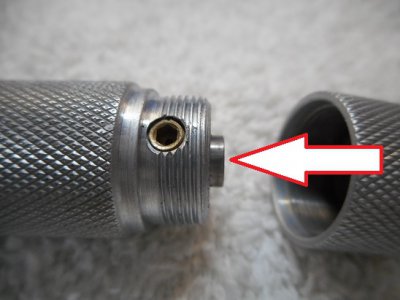Due to the holiday today was my first opportunity to give this another attempt since we've been discussing it. Following the comments everyone offered here, I decided the most likely approach would be to try and separate the main thimble body into two parts at the division between the knurled sections. With another application of penetrant and a little heat from a hot air gun, I clamped one end of the thimble in a soft jaw vice and gripped the other end with soft faced pliers. I managed to break it loose; the thimble is indeed two parts that screw together. Inside there was evidence of some rust that must have been holding them stuck. It took a fair amount of force to break it loose. The way they are machined there is a shoulder that overlaps where the two halves join, which was giving the illusion that the whole thing was a solid one piece component.
With the thimble halves separated it became obvious how the spindle is held into the thimble. There is a tiny set screw on the side of the thimble that goes directly against the spindle (see pics below). Even that little set screw was difficult to loosen. And with it retracted the spindle was still frozen in position. I had to clamp the exposed end of the spindle in the soft jaw vice and work the thimble with the soft faced pliers to loosen it. Then adjusting the calibration was a matter of some trial settings and checking against a calibration block.
I cleaned and lubed things, reassembled, and repeated everything on the other three micrometers in the set. One of them was much more problematic than the rest - and as luck would have it that was the one I was first attempting to work on last week (featured in my first post).
Here is what it looks like with the thimble separated and exposing the locking set screw:


If it helps anyone else, here are a few points with this design of micrometer:
1) The ratchet mechanism has nothing to do with the calibration adjustment or the spindle/thimble interface. It is a separate item screwed onto the end of the thimble's cap.
2) There is no friction/interference fit on any of the components. Everything either slides freely or is threaded.
3) The little set screw is what anchors the spindle in place in the thimble. The thimble threads into the barrel, with a tension adjustment. The barrel is pinned solidly into the frame.
Thanks to everyone for all of the advice and support.





